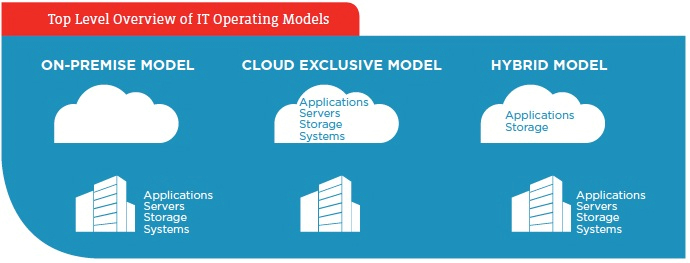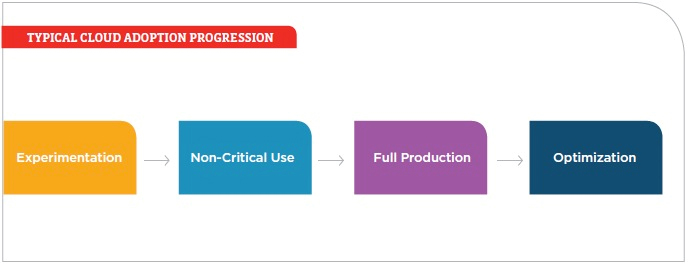Cloud Solutions

Scalable | Agile | Enabling
Delivery of IT services is heavily reliant upon connectivity to service an ever increasing mobile workforce. Demanding scalable yet robust solutions more organisations, from sole traders to multi nationals, are pushing more services into the cloud, controlling costs but maximising functionality on the move.
Whether 'Software as a Service' (SaaS), 'Platform as a Service' (PaaS) or 'Infrastructure as a Service' (IaaS) cloud services has helped organisations develop without major investement by moving away from the traditional 'On-Premise' model to exclusive cloud or hybrid models as shown below;

In the not-too-distant past organisations maintained their IT systems and applications internally, or on the premises of their office building. Today, organisations tend to fall into the hybrid category, and to a slightly lesser extent, the cloud exclusive category. One subtlety of this framework entails the use of public clouds and private clouds, which when used in conjunction may be characterised as a hybrid approach.
For many organisations, the typical pattern of cloud adoption starts with experimentation and progresses through optimisation. Note: optimisation does not necessarily mean 100% cloud. Depending on business objectives and a number of other factors, optimisation may mean a hybrid model leveraging the best of the cloud and the best of on-premise IT systems.

Moving away from traditional on-premise solutions the cloud offers benefit of;
reducing capital investment - rapid deployment - reduction in administration - scalability - budget control - featureful benefits
A Quick Guide When Considering Cloud Services
 |
CLOUD PRIMER: IS THE CLOUD A GOOD FIT FOR YOU BUSINESS?What are the components of the cloud ecosystem? How do they expand options for business? What are the typical stages of cloud adoption? |
 |
CLOUD CONSIDERATIONS AND DECISION FACTORSWhat are the key value propositions of the cloud? And, what are the cautionary factors that must be evaluated? Self-assessment: what are your organisation’s priorities and how do they map to cloud solutions? |
 |
QUESTIONS TO ASK BEFORE BUYINGWhat discussions should take place with solution providers (KNL) or internal staff to get maximum return from your investment? |
Cloud Considerations and Decision Factors
Any business investment decision requires weighing a range of decision factors, including the needs of stakeholders, alignment with corporate objectives, functional requirements, the pros/cons of each offering, and of course, the total cost of ownership (TCO). An understanding of the cloud value proposition factors and the cloud cautionary factors helps to analyse the cloud investment potential.
Cloud Value Proposition Factors
Pay-as-you-go cost model Typically a monthly operational expense (opex) paid during the period of usage, rather than a large upfront capital expense (capex).
Pay-for-what-you-need usage model Fees may be based on the number of users, the amount of storage, compute instances or some other metric. This model minimizes overpaying for unused resources.
Scalability Rapidly add users or capacity in peak times; scale down during off peak times.
Speed and agility Get up and running quickly (under many cloud use scenarios).
Enabler of innovation Add new capabilities, leverage APIs, free up IT staff time from routine IT maintenance to focus on innovation.
Mobility / remote access Many cloud solutions provide superior mobility/remote access capabilities compared to on-premise solutions.
Time savings The responsibility for software updates, patches and other routine maintenance tasks shift to the cloud service provider, freeing-up IT staff time.
Levels the playing field Cloud services expands the depth and breadth of technology available to small and medium size businesses, allowing them to compete with much larger firms.
Security improvements In an interconnected world, on-premise IT systems are not as safe as they may appear. Cloud service providers invest heavily in security technology and expertise and are especially adept at thwarting certain types of security attacks.
User friendly Many “born in the cloud” services are designed with the Internet and the user experience in mind, providing a superior experience over legacy software applications.
Backup / disaster recovery With on-premise IT systems, a natural disaster, fire or other issue could compromise business operations. Generally, cloud solutions provide superior backup and disaster recovery.
Cloud Cautionary Factors
Broadband dependent Cloud solutions are only as good as the speed and reliability of the Internet connection.
Integration challenges Few IT systems or applications operate in isolation. Cloud services will inevitably need to interact with other systems or applications. Integration can be a significant challenge.
Unexpected costs Over time, monthly cloud service fees add up. Over a long enough time horizon, they may exceed a one-time on-premise IT investment. Additionally, integration costs or peak demand requirements may drive total costs higher than expected.
Vendor lock-in How easy is it to retrieve and move data or systems from one cloud vendor to another cloud or back to an on-premise IT system? There are new tools making this easier, but it may still be challenging.
Reliability Even the largest of cloud service providers have experienced downtime. Other cloud service providers have gone out of business or were acquired. Overall, cloud service provider reliability is very high, but it is a factor that must be considered.
Flexibility / control tradeoffs Public cloud services by their definition are shared among many users. While this offers efficiencies, it limits control and the ability to customize the solution.
Process / policy requirements In some situations, the technology is the easy part. The challenge comes in adjusting workflow, processes and event the employee mindset. Cloud solutions may spur the need for new processes and policies.
Performance Not all cloud service providers are created equally. Some IaaS, PaaS or SaaS providers may be better than others.
Security While elements of security may improve in a cloud environment, other new vulnerabilities may be exposed.
Regulatory uncertainty Does your organization operate in a heavily regulated industry such as healthcare, or handle sensitive data such as the financial sector? Federal and state laws regarding privacy, data breach notification and much more continue to evolve.
Confusing service level agreements (SLAs) AKA, the fine print.
Before jumping into evaluating cloud solutions, it is worth spending some time with a quick internal assessment, it is premature to begin cloud service purchasing without a bit of introspection. It is not uncommon to have areas of uncertainty in the purchase. Refinements can always be made along the way as business objectives and needs are clarified.
When you are ready to move to the the next stage or need some additonal help in your internal assesment contact KNL.














